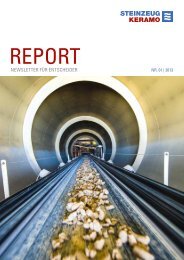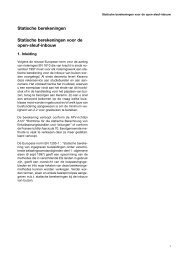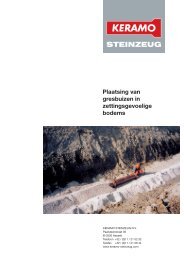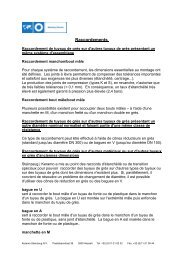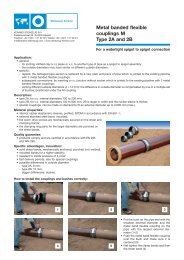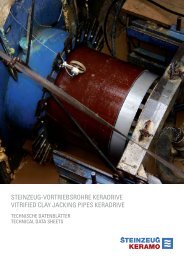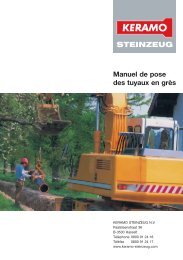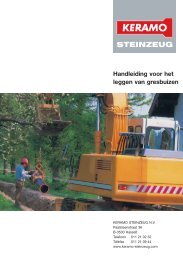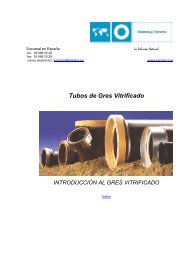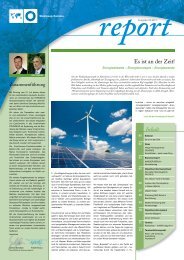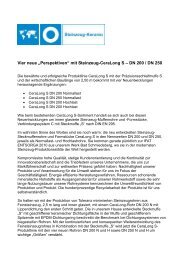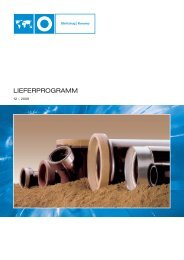mohring engels.indd - Keramo Steinzeug
mohring engels.indd - Keramo Steinzeug
mohring engels.indd - Keramo Steinzeug
You also want an ePaper? Increase the reach of your titles
YUMPU automatically turns print PDFs into web optimized ePapers that Google loves.
Fig. 9: Pilot pipe jacking<br />
system work below the water table is now also possible.<br />
The thrust boring of DN 200 sewers in section lengths<br />
which is now feasible is acquiring pre-eminent importance.<br />
The accurate underground driving of sewers of<br />
this nominal size at the customary section lengths was<br />
not possible earlier with the thrust-boring systems<br />
available on the market. From the inception of microtunnelling<br />
the conveying equipment to be incorporated<br />
inside the jacking pipe for moving the displaced soil, including<br />
protective tubing for cables, and the essential<br />
optical channel for the laser beam to control the advance<br />
determined nominal size DN 250 as the smallest crosssection<br />
of access-hole length drivable underground. For<br />
operators this meant that for constructing collectors<br />
they had to dispense with the customary smallest nominal<br />
size DN 200 if on economic grounds or because of<br />
compelling local factors enclosed construction methods<br />
had to be preferred to conventional sewer construction.<br />
Fig. 10: Pilot pipe jacking, final<br />
phase: after-pushing of the vitrified-clay<br />
pipe from a DN 2000<br />
starting shaft<br />
How widespread DN 200 is in the public sewage systems<br />
is shown by figures from the BWB’s combined and<br />
domestic/industrial sewage systems: some 32% of the<br />
BWB’s 8613-km long sewage system is of this nominal<br />
size. Particularly in the separate systems’ domestic/industrial<br />
sewage networks large parts of the drainage areas<br />
can be developed with DN 200 circular cross-sections<br />
and are hydraulically fully adequate for all operational<br />
requirements. If one considers the Berlin domestic/industrial<br />
sewage networks alone, DN 200’s share is<br />
as much as 65%. Because of this special importance<br />
operators have never abandoned the desire and requirement<br />
to be able one day, with improved technology, for<br />
controlled driving of DN 200 pipes too. This has now<br />
been made possible by the work of three German machinery<br />
producers in particular and provides planners<br />
and operators with other alternatives and the means of<br />
investing more economically since sewer construction is<br />
becoming more cost-effective.<br />
The requirements of ATV A 125, Section 6.2.2 governing<br />
the measuring and logging of runs of piping in the construction<br />
of jacking systems are met. During the jacking<br />
process, for example, the image on the monitor in the<br />
starting shaft can be continuously recorded by a videorecorder.<br />
All possible deviations are thus registered.<br />
Moreover, when product pipes are installed, the jacking<br />
pressure can be recorded by a pressure transducer with<br />
a memory by a recording manometer of the peak value<br />
in the measurement period.<br />
Thrust-bore pipe jacking<br />
Micro-tunnelling Page 11<br />
Here the product pipes are advanced at the same time<br />
as soil is displaced at the face by a cutting head. The<br />
soil is continuously conveyed to the starting shaft by<br />
augers. The augers are in a steel tube inside the jacking<br />
pipe. With each installed pipe the auger and pipe string<br />
is lengthened. The conveying pipes have skids and, like<br />
the augers, are adapted to the bore of the particular pipe<br />
to be jacked.<br />
In the starting shaft the soil is collected in a steel bucket<br />
during a jacking period and conveyed to the surface<br />
during the coupling operation. In this way the quantity<br />
of soil actually removed at the face is reliably monitored.<br />
An alternative to bucket extraction is to set up a sump in<br />
the starting shaft and convey by pumping. Fig. 11<br />
shows a thrust-boring container with a Soltau thrustbore<br />
pipe jacking system.<br />
Cutting head and augers are normally driven from the<br />
starting shaft. For heavy soils it is necessary to have<br />
available consistently high torque to comminute the<br />
drilled matter effectively. From DN 400 upwards pipejacking<br />
machines are therefore also offered with directly<br />
driven cutting head and separately driven augers.



